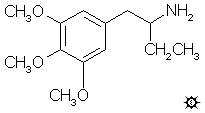
#1. AEM
alpha-ETHYLMESCALINE; 2-AMINO-1-(3,4,5-TRIMETHOXYPHENYL)BUTANE; 1-(3,4,5-TRIMETHOXYPHENYL)-2-AMINOBUTANE
|
| [3D .mol structure] |
A stirred suspension of 5.9 g LAH in 310 mL anhydrous Et2O was held at a gentle reflux in an inert atmosphere. A solution of 8.5 g 2-nitro-1-(3,4,5-trimethoxyphenyl)butene-1 in 125 mL Et2O is added drop-wise over the course of 0.5 h. The reaction was maintained at reflux for 6 h, then cooled, and the excess hydride destroyed by the cautious addition of 300 mL 1.8 N H2SO4. The phases were separated, and the aqueous phase brought to a pH of 6 by the addition of a saturated Na2CO3 solution. The neutral solution was brought to a boil, and clarified by filtration through paper. To the hot filtrate there was added a solution of 8.9 g picric acid in 100 mL boiling EtOH. The mixture was stirred and cooled, with the formation of a heavy yellow crystalline mass. After standing in the ice tub for several hours the mixture was filtered, providing 8.0 g of the picrate salt with a mp of 176-181 °C from H2O. A solution of this salt in 300 mL boiling H2O was treated with 60 mL concentrated HCl. On cooling, there was a deposition of picric acid, which was removed by filtration. The aqueous filtrate was washed with 3x50 mL nitrobenzene, then with 3x50 mL Et2O. The pH was brought above 9 by the addition of aqueous NaOH, and the filtrate was extracted with 3x100 mL CH2Cl2. Removal of the solvent from the pooled extracts gave a nearly colorless oil, which was dissolved in 300 mL anhydrous Et2O and saturated with hydrogen chloride gas. The white crystals of 2-amino-1-(3,4,5-trimethoxyphenyl)butane hydrochloride (AEM) were removed by filtration, Et2O washed, and air dried. They weighed 4.72 g.
DOSAGE: greater than 220 mg.
DURATION: unknown.
EXTENSIONS AND COMMENTARY: The extension of the two-carbon chain of mescaline by alpha-methylation to the three carbon chain of TMA approximately doubled the potency of the compound. And it was felt to be a completely logical possibility that, by extending it one more carbon atom, to the four carbon chain of alpha-ethyl-mescaline, it might double again. And following that logical progression, the doubling of potency with each additional carbon atom, the factor would be 2 to the 7th power by the alpha-octyl (or 256x that of mescaline, or a milligram as active dose) and with a side chain of a 70-carbon alkyl group (alpha-heptacontylmescaline) it would take just a single molecule to be intoxicating. This was rich fantasy stuff. As an active compound, just where would it go in the brain? With an 80-carbon side-chain, would one-thousandth of a single molecule be enough for a person? Or might a single molecule intoxicate a thousand people? And how long a chain on the alpha-position might be sufficient that, by merely writing down the structure on a piece of paper, you would get high? Maybe just conceiving the structure in your mind would do it. That is, after all, the way of homeopathy.
Maybe it was just as well that this added two-carbon side-chain with lowered activity was already enough to disprove the doubling pattern. But by the time this non-activity had been learned, the alpha series had already been pushed out quite aways. The machinery of making the appropriate nitroalkane was straightforward, by reaction of the alkyl halide with nitrous acid, and separating the unwanted nitrite ester from the wanted nitroalkane by fractional distillation. The nitrostyrenes all formed reasonably although often in terrible yields, and reduced reasonably, and all formed crystalline picrates for isolation and crystalline hydrochloride salts for pharmacological manipulation. But since the first of these, AEM, was not active, there was no enthusiasm for tasting anything higher. This family was never published; why publish presumably inactive and thus uninteresting material? The Table presents the properties of the precursor nitrostyrenes, and the product picrate and hydrochloride salts, at least whatever information I can still find after thirty years:
TABLE. Physical Properties of the alpha-Alkylmescaline Homologues and their Precursor Nitrostyrenes
Code Name NS mp °C picrate mp °C HCl mp °C
APM Alpha-propylmescaline 82-83 214-218 ABM Alpha-butylmescaline 73-74 169-174 182-184 AAM Alpha-amylmescaline 54-55 162-163 155-158 AHM Alpha-hexylmescaline 51-52 ASM* Alpha-heptylmescaline 43-44 AOM Alpha-octylmescaline ** ANM Alpha-nonylmescaline 46-47 *** AUM Alpha-undecylmescaline ***
* S is for septyl, to distinguish heptyl from hexyl. **Never made, as no nonylbromide could be located to make the needed nitrononane. ***The synthesis got as far as the nitrostyrene stage when the inactivity of AEM was determined, and the project was dropped.
| [ |
[Main Index] | [Forward |

